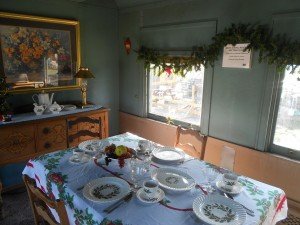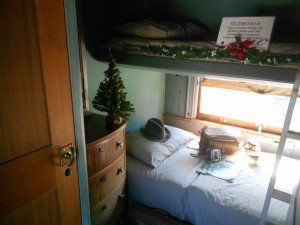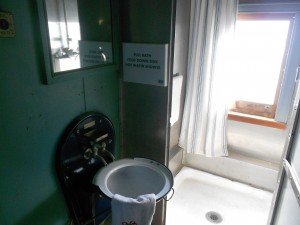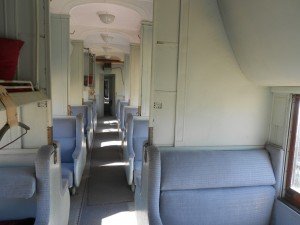Trips Into History visits two of the famous Pullman Cars, the railroad cars that revolutionized passenger train travel in the late 1800’s.
Thank you for reading this post, don't forget to subscribe!
In the 1800’s, comfortable travel was a relative term. As opposed to the covered wagon, a stage coach could be called comfortable although that can be argued. When the iron rails spread throughout the western U.S., the train was certainly a step up from both of these modes of transportation.
The two biggest improvements in passenger comfort offered by the railroads would most certainly have been the Fred Harvey Houses and later the Fred Harvey AT & SF Railroad dining cars. The other beyond a doubt were the Pullman Cars. The Pullman train cars offered a whole new way to travel.
The Pullman Passenger Cars were built by the Pullman Palace Car Company established in 1867 in Chicago Illinois. Prior to establishing this firm, George Pullman had worked as a cabinet maker and contractor. George Pullman’s company built rail cars from the mid 1800’s into the early 1900’s.

The Pullman Company was of such a size that there was even a town built for it’s workers in 1880 south of Chicago and west of Lake Calumet. The town was given the obvious name of “Pullman“. This town would also become ground zero during the violent Pullman Strike during the 1890’s financial depression. This was a strike that ended only with the introduction of federal troops under the command of famous Indian War General Nelson Miles and with the arrest of Eugene Debs.
Two Pullman Cars featured int this article are the Pullman Business Car and the Pullman Sleeper. The sleeper car is what most people think of when they refer to the Pullman cars.

The Pullman Business Rail Car
Shown here is the 1924 Pullman Business Car Number 404. The car served on the Atchison Topeka & Santa Fe Railroad. The rail car was used by the Eastern Division Superintendent of the AT & SF who was stationed in Emporia Kansas.
The Pullman 404 is very impressive. The train car is 60 feet long and weighs 60 tons. It was one of seventeen similar rail cars built by the Pullman Company. The Pullman Business Car was also referred to as a “private car” which it was. In addition to it’s use as a perk for the railroad superintendents, the business or private car was also the calling card of the wealthy. Many if not most of the well known millionaires of the late 1800’s had there very own Pullman Car. Often the private car would be attached to a regularly scheduled train. During that era, it was THE way to travel by train.

The 1924 Pullman Business Car was essentially a combination office and residence. This Pullman car had a dining room, meeting room, two staterooms, a bathroom with a shower. It could take the superintendent anywhere along the AT & SF route with the comforts he would have had in Kansas. The rail car also provided a room for a porter which was standard during that era.
The Pullman Sleeper
When these Pullman cars were introduced they were an instant hit. The Pullman Sleepers helped civilize rail travel, especially long distance rail travel. There were actually rail cars that were referred to be sleeper cars as early as the 1830’s. These were however very primitive and are not of the same quality and comfort that one associates with the famous Pullmans.

The Pullman Sleeper Car featured in this article is the 1924 “McKeever” Pullman Sleeper. The McKeever is a twelve section, fifty-five passenger car. Measuring 80 feet, 11 inches long, the rail car was built and operated by the Pullman Company. Similar to the Amtrak Sleeper Cars today, this Pullman had both upper and lower sleeping births. The porter would rearrange the compartment when the passengers were either dining or socializing. The rail car had bathrooms on both ends of the car, one for males and one for females. The mens room also had an added area used as a smoking room.
This car had air conditioning installed in 1935 and remained in service until 1964. The McKeever was a regular on the New York to San Antonio route. The car was so popular with travelers that many planned their trips to New York when the McKeever was going to be on the run. Interestingly enough, the way railroads were operated during the early to mid 1900’s, a passenger might travel on several lines during a long trip. When the McKeever car was in transit to New York from Texas it would be hooked onto other rail lines however the car kept it’s same staff during the entire journey. This alone would make it popular for rail travelers.

An interesting story about George Pullman and his early success manufacturing luxury rail cars actually had a lot to do with the assassination of President Abraham Lincoln. George Pullman offered the use of his Pioneer car to Lincoln’s widow during her trip to Springfield Illinois for her husband’s burial. Mrs. Lincoln’s trip in the Pioneer made Pullman and his cars known throughout the U.S. This publicity even encouraged industrialist Andrew Carnegie to invest in Pullman’s business.
A related photo article on our Western Trips site you’ll enjoy is the Fred Harvey AT & SF Cochiti Dining Car...Also on Trips Into History see our photo article on the Railroad Post Office Car.
The Pullman Cars on Display
Both of these restored Pullman Cars and much more are on display at the Texas Transportation Museum in San Antonio Texas. The museum also has on display a vintage 911 Baldwin steam locomotive and excellent exhibits of a 1924 Buffalo Fire Engine, horse drawn carriages, a model railroad setup and vintage classic automobiles. If your Texas trip takes you to the San Antonio area a visit to this museum would be a fun stop for the entire family. Train rides are available with admission Saturday and Sundays. The museum is located at 11731 Wetmore Road, San Antonio.
(Photos from author’s collection)
